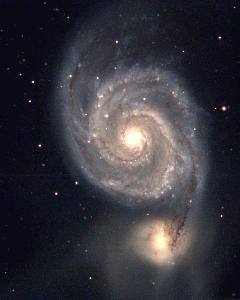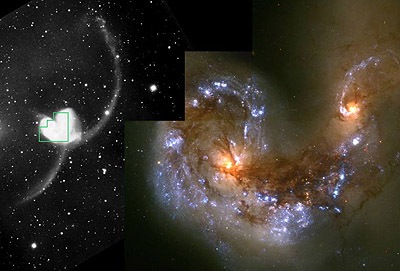9. COLLIDING GALAXIES:
|

|
|
Stefan's Quintet. Two galaxies to the right center are colliding.
A third galaxy in the upper left is distorted by the gravity of the
colliding galaxies. The galaxy in the lower left is a foreground galaxy,
not physically associated with the other three. Source.
|
Galaxies in clusters are close enough and big enough that they
often pass nearby each other, as illustrated above. In that case, the gravity
due to a passing galaxy can perturb the orbits of the stars about the center
of the other galaxy, causing great tidal distortions of the shape of each galaxy.
In fact, we now know that these tides can easily cause new spiral arms to form
in a disk galaxy. Hundreds of millions of years thereafter, the spiral arms
may wind up more and more tightly, as the galaxy changes its morphology from
type Sc to Sb to Sa. For example, the spiral arms of the Milky Way may be a
result of gravitational tides due to its satellite, the Large Magellanic Cloud.
Another example is shown below.
|

|
|
The "Whirlpool Galaxy" M51.
The spiral arms are probably caused by the gravitational tug of its
satellite, NGC 5195.
|
In fact, sometimes galaxies will "collide," passing right through
each other. I put "collide" in quotes because it is unlikely that any stars
will actually hit each other during such collisions, since interstellar distances
are so great. But the collisions will greatly disturb the orbits of the stars,
leaving highly deformed galaxies.
The hydrogen gas in spiral galaxies can often be seen at the
outer reaches of the galaxy, beyond the visible stars. By observing this gas
with radio telescopes, one can sometimes trace the history of the collisions
of the galaxies. You can find a very good example in Min
Yun's M81 HI Home Page.
|

|
|
Two views of NGC 4038/4039, the "antennae", a pair of colliding
galaxies. On the left is a ground-based image, showing two long streams
of stars flung out by rapidly changing gravitational forces during the
collision. On the right is an image of the green inset region on the
left from the Hubble Space Telescope, showing many clusters of newborn
blue giant stars. Source
|
More than 300 years ago, Isaac Newton wrote down the equations
that describe the motions of stars and planets due to their mutual gravity,
and his solutions describe the orbits of the planets and comets very well. We
can use these same equations to describe the collisions of galaxies. But it
is much more difficult to solve Newton's equations when we must describe the
motions of billions of stars all tugging on each other instead of just one planet
or comet tugged by the gravity of the Sun. But today, astrophysicists have learned
to simulate collisions of galaxies by solving such equations on the world's
largest computers.
Here's a movie
(source)
by Joshua E. Barnes of the University of Hawaii illustrating a simulation of
the collision of two counter-rotating spiral galaxies. This particular simulation
produces a pair of interacting galaxies that appear very similar to the antennae.
This collision was a few hundred millions of years. If this movie continued,
you would see the two galaxies merge together into a single galaxy that would
resemble an elliptical galaxy. Here's a sequence
of images of galaxies representing various stages of
such a collision. We can estimate the time since the collision began for each
of these images from the colors of their globular star clusters. In the early
stages of the collision the star clusters are blue because they have many newly-formed
blue giants, while in the late stages the clusters are red because all the blue
stars have evolved and become red giants (see Lesson
5).
Although the stars in galaxies miss each other when galaxies
collide, the interstellar gas in the two galaxies, which fills the space between
the stars, must crash. When it does, the gas is compressed and this compression
can trigger a huge outburst of star formation called a starburst.
We see an example of collision-induced star formation in the Hubble image of
the Antennae galaxies above. (source: Hubble
Reveals Stellar Fireworks Accompanying Galaxy Collisions).
Another interesting example of star formation caused by collisions
of galaxies is the Cartwheel
Galaxy, shown above. In this case, a smaller galaxy
(probably the blue one on the right) passed almost straight through the center
of the larger one on the left, sending an expanding circular compression wave
through its interstellar gas. New stars are being formed in this big "splash".
Because star-forming regions contain many luminous blue and
red supergiant stars, starburst galaxies are exceptionally luminous, especially
at infrared wavelengths. They are more common in the early universe, when galaxies
were colliding more often than they are today.
One of the few galaxies that is moving toward the Milky Way is
M31,
the other giant spiral galaxy in the Local Group. Perhaps in a few billion years
M31 will crash into the Milky Way. Here's a computer simulation of the Impact
of the Milky Way and M31 by John
Dubinski.
Want to have some fun: simulate your own galaxy collisions with
Galaxy
Crash, by Greg Bothun and Chris Mihos.
When a small galaxy collides with a large galaxy, the large galaxy
merges with it in a process called cannibalism.
When it absorbs the smaller galaxy, the larger galaxy will swell up somewhat
because it is "heated" by the energy of the high-speed stars from the small
galaxy. Such cannibalism occurs commonly in clusters of galaxies and is responsible
for the existence of very massive galaxies often found at the centers of such
clusters. Here's a computer simulation
of this process by John
Dubinski. A good example of a big fat cannibal that
has obviously eaten many smaller galaxies is the giant elliptical M87
in the Virgo Cluster of galaxies, which we have already discussed in the context
of its X-ray emission. For more examples, see Hubble
Sees More Evidence of Galactic Cannibalism and A
Collision in the Heart of a Galaxy.
(Return
to course home page)
Last modified March 30, 2002
Copyright by Richard McCray



